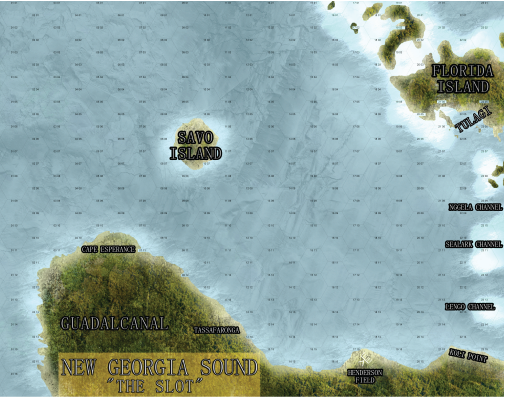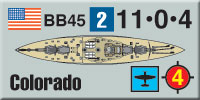| South Pacific:
The Glorious Ironbottom Sound Map
By Mike Bennighof, Ph.D.
September 2022
 No other tiny patch of water saw more fighting during World War Two than the Sealark Channel just north of Guadalcanal, what become known to American sailors as “Ironbottom Sound.” That intensity gives us the opportunity to do something special in Second World War at Sea: South Pacific. No other tiny patch of water saw more fighting during World War Two than the Sealark Channel just north of Guadalcanal, what become known to American sailors as “Ironbottom Sound.” That intensity gives us the opportunity to do something special in Second World War at Sea: South Pacific.
A sea zone in Second World War at Sea games is 36 nautical miles across. At our standard Tactical Map scale of 4,000 meters across each hex, Ironbottom Sound fits that almost exactly with the same big fat hexes as on the Tactical Map. And so we made a special Ironbottom Sound tactical map for South Pacific, with artwork by Tiffany Munro.
It’s larger than the standard Tactical Map, but the navigable water is actually slightly less (it doesn’t look that way, but that’s an optical illusion – there are islands taking up some of the space, and some of the water is off at the west or north edge behind an island and won’t usually be in play).
The Ironbottom Sound map sees a lot of use, both in dedicated battle scenarios taking place just on the Ironbottom Sound map, and in operational scenarios when contact is made in the waters just off the north shore of Guadalcanal.

As far as the basic rules of play go, the new Ironbottom Sound map is used almost like the standard blue Tactical Map. Ranges (sighting, gunnery, torpedo) remain the same. But there are some pretty important differences. Time moves more slowly on this special map, with special rules for gunnery and for torpedo reloading to reflect that. And of course, there’s a lot of land, with the attendant shallow waters where you can run your ships aground, and coral-clogged channels at the eastern edge of the Sound. But otherwise, it’s all the same; you’ll be able to shift right into moving and fighting on this new map without any special rules learning required.
There are, by my count, 21 battle scenarios taking place on the Ironbottom Sound map. We have, of course, all of the historical clashes: Savo Island, First and Second Naval Battles of Guadalcanal, Cape Esperance, Tassafaronga. Most of those involved cruiser-destroyer groups, with some having only destroyers on one side (Tassafaronga, where the destroyers won) and the Guadalcanal battles famously involving battleships.
The stretched-out time scale allows us to give these battles a deeper look, breaking them down into shorter scenarios at key decision points. So you can second-guess Gunichi Mikawa at the Battle of Savo Island; having dispatched the American-Australian cruisers rather lackadaisically guarding the entrances to Ironbottom Sound, should he press on to savage the transports lined up along the beaches of Guadalcanal and Tulagi, or call it a night and head for home before the sunrise brings American air power? (Hint: Go for the transports, strand the Marines.)
You can also fight the battles that almost inexplicably did not happen, like the mid-September 1942 occasion when competing convoys unloaded in Ironbottom Sound a few miles away from one another yet did not fight. The Allies, who had the upper hand in firepower, apparently did not detect the Japanese, who unloaded their troops and slipped away.
 And of course, we have alternative possibilities – it would not be an Avalanche Press game otherwise. You can play Savo Island with the presumption of Allied command competence (they knew that the Japanese were coming!). You can play out Second Guadalcanal with the newly-arrived old battleships Colorado and Maryland in place of Washington and South Dakota. Japanese Admiral Isoroku Yamamoto swore that he would “place Yamato right alongside Guadalcanal” – well, you can hold him to his word and take the Hotel Yamato into battle (is she a match for two American fast battleships? You can try it out yourself.). And of course, we have alternative possibilities – it would not be an Avalanche Press game otherwise. You can play Savo Island with the presumption of Allied command competence (they knew that the Japanese were coming!). You can play out Second Guadalcanal with the newly-arrived old battleships Colorado and Maryland in place of Washington and South Dakota. Japanese Admiral Isoroku Yamamoto swore that he would “place Yamato right alongside Guadalcanal” – well, you can hold him to his word and take the Hotel Yamato into battle (is she a match for two American fast battleships? You can try it out yourself.).
In between the two Naval Battles of Guadalcanal, the Japanese conducted a bombardment of Henderson Field that went unchallenged. Now, you can challenge it (and see why the Americans let things be). The Japanese left Adm. Takeo Kurita’s Support Force behind for both battles (two more battle cruisers; they stripped Kurita’s force of cruisers and destroyers for the second battle, but left the big ships behind – it’s not clear why).
All of the historical battles get this same treatment – in addition to the straight-up “how it happened” version of the scenario, we take them apart at the key points of decision, and also look at them with alternative orders of battle, using ships that were available but not in use. We’ve done this before in other games, like Bismarck’s Second Edition, but those games all use the standard generic blue Tactical Map. These alternatives give you that many more opportunities to play on the Ironbottom Sound map.

The Ironbottom Sound map and the battle scenarios set on it would make a complete game all on their own. And that would be a fun game. But those are just some of the battle scenarios in South Pacific, the scenarios designed to use the Ironbottom Sound Tactical Map only. Beyond that, we put those battles inside a larger frame: you can play not just the battles in Ironbottom Sound, but the operations that led to them.
The operational scenarios take place on the operational map (duh), which covers this slice of the South Pacific at a scale of 36 miles across each zone; it reaches from Jaluit Atoll in the upper right corner on down to Mackay, Australia in the lower left; Truk (the big Japanese naval base in this region), Espiritu Santo in the New Hebrides and Noumea on New Caledonia (the latter two serving as Allied bases) are all on the map.
The map is almost exactly centered on Henderson Field, Guadalcanal (the same zone also includes the Tulagi seaplane base). That’s also where the operational action is centered, with both the Japanese and the Americans seeking to bring reinforcements there or deny those missions to the enemy. That means even more surface action on the Ironbottom Sound map; when there’s contact in Sea Zone AF 25 (Ironbottom Sound), you fight it out on the Ironbottom Sound map.
With the Ironbottom Sound map and the battle scenarios fought out on it, plus the larger framing of the operational scenarios and our story-arc chapter structure tying them together, South Pacific becomes a deep experience in historical gaming, at multiple levels. There’s nothing else like it in the known universe.
You can order South Pacific right here.
Please allow an extra six weeks for delivery.
Sign up for our newsletter right here. Your info will never be sold or transferred; we'll just use it to update you on new games and new offers.
Mike Bennighof is president of Avalanche Press and holds a doctorate in history from Emory University. A Fulbright Scholar and NASA Journalist in Space finalist, he has published a great many books, games and articles on historical subjects; people are saying that some of them are actually good.
He lives in Birmingham, Alabama with his wife and three children. He will never forget his Iron Dog, Leopold.
Want to keep Daily Content free of third-party ads? You can send us some love (and cash) through this link right here.
|
